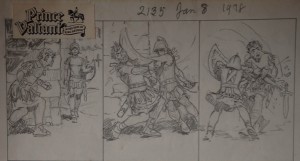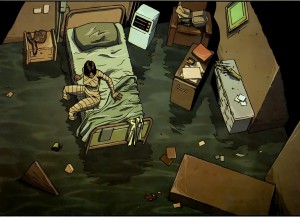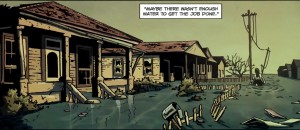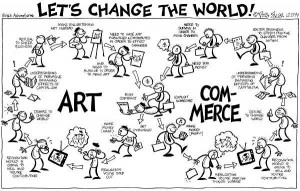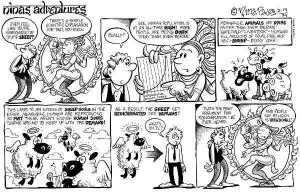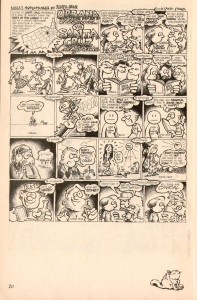To finish up our roundtable on copyright I thought I’d highlight some of the more interesting comments.
First, Nina Paley very kindly stopped by. Her comments start here. In one of the most pointed she said:
My focus is not on changing the laws – that is extremely unlikely. Copyright will become increasingly draconian, because of of our rather corrupt congress and campaign finance system.
Interestingly, I mentioned in the interview that back in the day, when women criticized misogyny in certain underground comics, they were accused of “trying to censor.” As I demonstrate viable alternatives to copy restrictions, people argue back as if I’m somehow trying to “remove copyright entirely.” I can’t remove copyright, and even if I could, I don’t support dictatorial, unilateral legislative changes that don’t reflect the will of the public – that’s how we got the copyright mess we’re in now.
What I am trying to do is increase public awareness of what copyright is (an artificial monopoly), how it works (through censorship), and what we can do in the midst of a broken system. Many wonderful opportunities exist for artists right now, but no one needs to take them. I win either way: if more works are freed, I live in a freer society, and if more works are locked up, my free works enjoy a competitive advantage.
Over at his blog, animator Mark Mayerson touches on some issues particular to film.
I agree that Paley has something of the “zealousness of the convert.” Because a copyleft approach worked for her, she assumes that it is the right way to go and will work for everyone else. I think the Newman interview in the roundtable makes some very good points in refuting Paley.
There are so many issues wrapped up with this. First is the length of the copyright term. What’s the right length to benefit the creator and his/her heirs while still allowing for a vibrant public domain? Right now, it’s an open question as to whether anything will ever again be added to the public domain except by accident.
Then there’s the issue artists and corporations. Newman, as a composer, is creating complete works without the aid of others. It’s natural for him to hold the copyright. Even though Paley made Sita by herself, she included other works on the soundtrack. Paley is a rare case in that the majority of films are created by more than one person. In that case, who should hold copyright or how should it be split? What rights do financiers have relative to creators?
I think we can all agree that artists should have more ownership of their work (as opposed to corporations owning it), but should corporations vanish, we’re still left with some difficult questions.
There’s a fairly lengthy comment thread over at Sequenza21 inspired by Jonathan’s post. One interesting comments from composer John Mackey.
I’m also of the belief that your potential performer, like any person, has a mindset that you get what you pay for. If you don’t believe enough in your music to feel you should be compensated for it, how good is your potential performer going to think it is when they happen upon it online? If you, literally, can’t even GIVE it away, why would somebody think it was going to be good enough to take the time to even listen to the MP3 or look at the free score? It goes to something Eric Whitacre said once, and I’m going to get the quote wrong, but it was essentially, “nobody wants a free futon from Craigslist, but a whole lot of people would pay $50 for that same futon on Craigslist.” (I think his quote was actually more along the lines of “nobody will pay $10 for a futon, but everybody will pay $100 for a futon,” but the point is the same.) Charge something for it — and that’s a right that copyright law provides — and suddenly it’s “worth” something. A free futon is just gross.
And another from Chris Becker.
I do know from friends who have or currently write music for television (and I’ve done this as well…) that big corporate media entities have made every effort to cut down on the amount of money they are willing to shell out to composers because of the availability of license free music. Their attitude is: “Look, we can get this music for free OR my kid can spit it out using a loop CD, so YOU punk ass composer should be grateful we’re even considering funding a day of recording sessions…”
Back on HU, commenter plok, a singer-songwriter and supporter of freer copyright, had a whole slew of entertaining comments, which you can scroll back and forth for. I’ll point particularly this one.
I wish you would stop saying “stealing”, though — we’re talking about copyright infringement, not theft, and it’s an important difference. What the record company’s doing to me isn’t the same thing as what downloaders are doing to it — it’s a lot worse. In the grocery store of my music, the downloader’s taken a grape and popped it in his mouth; the record company’s taken cash from the till.
Also, a very important thing I would like to communicate to you is that the downloaders are mailing me a cheque — in fact they’re mailing me several different cheques, just by doing what they do. The people who download are avid music fans, they attend concerts and purchase records and T-shirts and sometimes even beer for the musicians, but more importantly than any of that they make new fans…and every time they do, they pay a Blank Media Levy designed to compensate artists for copying activity that can’t be monitored or controlled. Although I don’t know how much I’d be getting from it, because I can’t bring myself to take that money as long as individual downloaders are not just paying it, but also being prosecuted for what we all know they’re paying it for. And especially not if it’s my music they’re downloading, because nothing says they have to download my music instead of somebody else’s!
I mean, I’m grateful they like it enough to want to own, and even share, a copy of it! Make no mistake, that is support, and if the RIAA was interested in monetizing the Internet as a promotional resource instead of as a retail outlet, that support would translate to a couple different kinds of new income for me…but the word “stealing” stands in my way, stands between me and that new revenue.
Short form: I see downloaders as radio listeners, not shoplifters. Which is why every time someone expresses outrage that those people are getting away with murder, I always make a point of saying “well, why not join ‘em?” Radio listeners successfully send money my way even though they don’t pay user fees; I don’t see why Internet listeners should have to pay anything more than that. If you don’t want to buy the CD or go to the show, I can’t make you do it by shaming or threatening you out of listening to the music…and I don’t want to do any of that anyway.
Eric B. addressed the question of whether those who download illegally are petulant infants
As for the “petulant infants” on the internet–I think it’s a bit trickier than that. I mean, if I see a dollar bill floating along the street, I’m likely to pick it up and put it in my pocket, if the rightful owner is nowhere in sight (This actually happened to me the other day). I’m not going to undertake a worldwide search to return the dollar bill…nor am I going to leave it floating around. While the internet downloading thing isn’t really equivalent, it does have that feel. There’s so much crap floating around out there, that it’s kind of like picking it up in the street. I have yet to download for free music that in my former life as avid CD purchaser, I would have purchased. That is…I try to ask myself, “would I be buying this” under other circumstances, and if the answer is yes, I’ll probably buy it (on iTunes or in physical form, or whatever)…But if it’s a matter of trying something new–or obtaining something that I otherwise probably wouldn’t have bought–well, I’ll let your imagination wander. Sometimes this kind of sampling leads to purchases (concert tix, other CD’s, songs by the artists I especially like) and sometimes it doesn’t. My income is very limited (or has been over the last 5 years or so)–but my appetite for music isn’t really, so I try to resolve those things. I buy a lot of blank media, so I guess some of my money finds its way back to those who profit, or whatever…Maybe this makes me a “petulant child” –but I’m guessing I’m not an atypical one. I don’t think I should be able to get anything I want for free…and I do support my artistic favorites…but I do think that it’s unwise to take a pie-in-the-sky view of this kind of thing. Just because it may be ethically “wrong” to download without paying, it will continue to happen regardless of changes in copyright law unless there is a way to stop it. Currently, there isn’t really.
And artist and critic Bert Stabler summarizes my discomfort with the Paley’s movie Sita Sings the Blues:
The word you all are looking for is “patronizing.” Whenever NPR profiles the latest Ry Cooder musical fusion crossover between Mongolian throatsinging and Cherokee nose fluting, with an electronic cumbia bassline, the reason your stomach should churn with shame as an educated privileged cultural consumer is because, ever so quietly, guilt is being atoned for with tokenism. There are worse things than trying to atone for sins, but hardly a more irritating way of going about it.
Caro has an impassioned defense of Sita in that thread too (she gets to compare me to Hindi fundamentalists.) And there’s lots more from Caro and me and lots of other folks if you click about.
Thanks to all of those who commented and to our guest posters, Pallas, Jonathan Newman, and Alan Benard. And thanks especially to Caro for inspiring the whole thing with her interview of Nina Paley — and to Paley herself. You can find the whole roundtable here.

